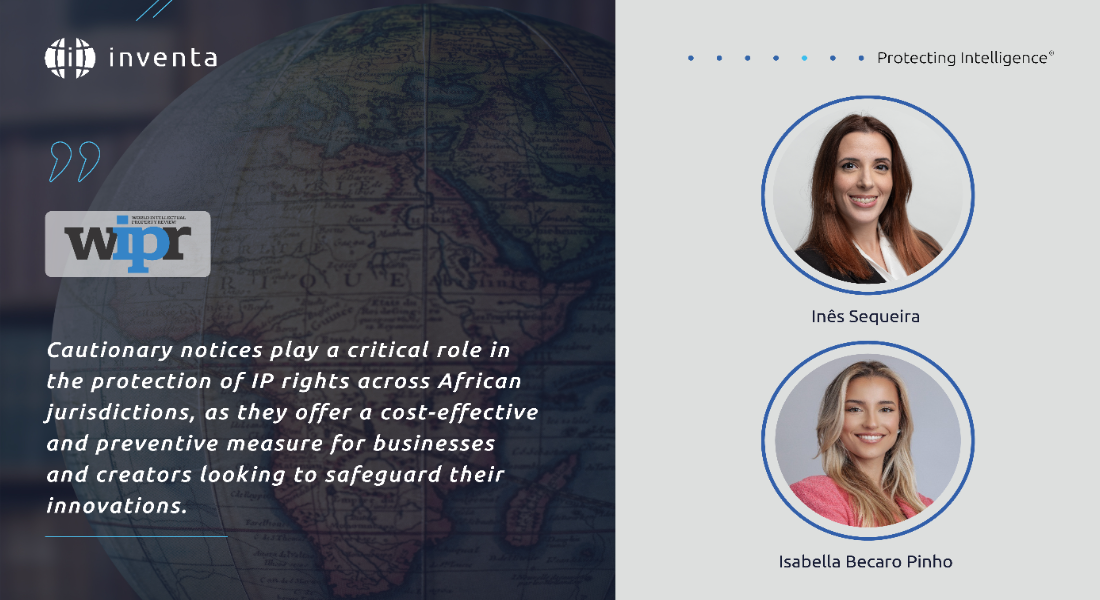
How cautionary notices protect IP across Africa
In recent years, the protection of intellectual property (IP) rights has become a significant concern across the African continent, as more businesses, companies, and entrepreneurs are looking for new opportunities to expand their businesses into the continent.
An important tool that can help protect these assets in Africa is the use of cautionary notices.
This is a public declaration issued by the owner of an IP right with the aim of making this IP ownership known and public, in order to claim it before a potential legal action, if necessary. These notices act as a warning to potential infringers and serve as a safeguard for intellectual property assets.
We will delve into the benefits of using this tool, as well as its possible challenges, its important role, and how it is effectively protected in countries where the only type of protection of intellectual property rights is by its means.
Understanding cautionary notices
Cautionary notices are a legal tool and a formal way to make the public aware of your intellectual property rights, more specifically, your patents, designs, and trademark creations in jurisdictions where access to guarantee the protection of these assets is a distant reality.
Typically published in a public journal, newspaper, or even through a well-known website of the government, these notices alert a potential offender that a certain trademark, design, or invention is in use and already has a proprietor.
The publication includes the details of the asset to be protected, declaring that the owner has the rights to explore his creation in the said territory. A notice in the public newspaper gives the presumption that people cannot allege that they haven’t seen or didn’t know about a specific trademark ownership in case of imitation or violation of the trademark’s owner rights.
In case of improper use, legal actions can be taken against any person or company who uses the protected trademark.
In some African jurisdictions, cautionary notices are used as a preventive measure against potential actions of non-use, illegal use, counterfeiting, or infringement of any forms.
They essentially establish a public record of ownership, strengthening the legal position of the IP holder.
In spite of these notices not having the same legal weight as a registered trademark, patent, or design, and not involving the process of formal examination, it can be a useful tool to enhance evidence of use and property, helping create an evidentiary record that can be used in potential future legal disputes.
The role of cautionary notices in Africa
The protection of IP rights in Africa often faces specific challenges in countries where enforcement is still in development, compounded by limited resources and a lack of awareness regarding the importance of these rights.
However, there are other African jurisdictions with robust IP systems, equipped with competent intellectual property offices that effectively manage infringements and protect registered trademarks for their owners.
In this context, cautionary notices play a crucial role in raising awareness and providing a glimpse into the practices of more developed countries.
1) Preventing infringement and misuse
Cautionary notices serve as a public dissuasion against infringement. It alerts the public to the existence of an intellectual property right, which reduces the risk of others consciously or unconsciously infringing on that right.
It adds an additional layer of protection, making clear that the owner is actively taking care of their rights.
2) Enhancing legal protection and enforcement
In many African jurisdictions, IP violations may not be addressed swiftly. A cautionary notice may be used as an important piece of evidence in legal disputes. In cases of infringement, the notice can demonstrate that the IP holder had previously made their rights known, which can strengthen their case in court.
3) Increasing public awareness and promoting business confidence
By publishing a cautionary notice, people who didn’t know about the existence of this kind of protection in that country will start to ask themselves what this tool is used for and be more attracted to its protection.
It starts to create a sense of belonging and encourages the creation of new businesses, as well as attracting the attention of large companies who would like to commercialise their products or services.
This helps the commercial landscape to work properly, promoting more jobs, art, new inventions, and especially, providing an incentive for those who invested time and resources creating a medicine, for example.
It brings back investment and time for researchers, presenting a new landscape and bringing hope and a different horizon both for the inventor and for the accessible products for the population, even if through a cost.
How cautionary notices work across different African jurisdictions
Eritrea
Eritrea is not a contracting party to the World Trade Organization (WTO) or the TRIPS Agreement. The country’s intellectual property framework is reportedly still under development.
In the absence of enacted IP legislation and an established competent authority for IP administration, enforcement of IP rights is severely constrained, as there is no applicable legal or institutional framework currently in place.
- Publication details: Online journal Eritrea Daily. No printed edition. We recommend proceeding with publication in English.
- Preparation and publication timeline: The notice is prepared in the required format for publication. It typically takes 1-3 business days to publish the cautionary notice in the journal.
- Online availability: Each cautionary notice will remain available online for consultation for a period of three days. Please note that only one cautionary notice is published at a time.
- Requirements: Formal instructions (eg, trademark details and applicant details).
- Re-publication recommendation: We recommend re-publishing the cautionary notice every 2-3 years to maintain visibility and effectiveness.
Somalia
After an extended period during which trademark registration was suspended due to the civil war in Somalia, trademark registration in this jurisdiction is once again possible.
The Somalia Trademarks Office resumed its operations following the issuance of Ministerial Decree 1/2019 by the Ministry of Commerce and Industry, which confirmed that trademark registrations are now permitted.
The Ministry of Commerce and Industry has commenced trademark registration based on the Somali Trademark Law No. 3 of January 22, 1955, as amended by Law No. 33 of January 18, 1975, and Law No. 3 of December 1987.
However, applications for patents, designs, or any other recordals are still not possible through official submission.
- Publication details: An online version in English will be available in the Hadhwanaagmedia online newspaper and a Somali version in the Mogadishu Times daily newspaper, at the same time.
- Preparation and publication timeline: Once the necessary information is provided, we prepare the notice in the required format for publication. The online and printed version are made available within two working days.
- Requirements: Formal instructions (eg, trademark details and applicant details).
- Re-publication recommendation: We recommend re-publishing the cautionary notice every 2-3 years to maintain visibility and effectiveness.
Somalilandia
Although Article 16(2) of the Somaliland Constitution states that “the law shall determine the rights to authoring, creating and inventing”, no trademark registration laws, systems or offices have been implemented yet.
- Publication details: The online version will be available online in the Somali language at the Somalilandsun, which is published every Monday, Wednesday, Thursday and Saturday. Once published, the printed version is released on the Horn Tribune, a weekly newspaper.
- Preparation and publication timeline: Once the necessary information is provided, we prepare the notice in the required format for publication. The online version is made available on the website within two working days. The print version is then published once in the Horn Tribune newspaper.
- Requirements: Formal instructions (eg, trademark details and applicant details).
- Re-publication recommendation: We recommend re-publishing the cautionary notice every 2-3 years to maintain visibility and effectiveness.
Benefits and hurdles of cautionary notices
A. Benefits
- Cautionary notices are more cost-effective and faster than a regular trademark registration process, which can take three years or even longer in some jurisdictions. However, we encourage the publication at least every two years to ensure that the notice is still published to those who may be concerned.
- It also helps prevent IP infringement by alerting the public to an IP holder’s rights and the potential consequences of infringement, thereby deterring misuse before it occurs.
- In the event of an infringement, a published cautionary notice can serve as a key piece of evidence that the IP holder has made their rights known. It is necessary to prove that you have publicised your IP right, so we also suggest saving it for future legal processes, if any.
B. Challenges
- The lack of awareness makes businesses and entrepreneurs unaware of the availability or importance of cautionary notices, reducing their potential effectiveness.
- Even with a cautionary notice, enforcement of IP rights may still be challenging and difficult in some jurisdictions, especially in countries with limited judicial or administrative capacity, as the enforcement of these rights usually depends on the good work of government bodies.
- In underdeveloped countries, the population's primary concern is securing essential goods and services. If companies do not begin entering these markets and view cautionary notices as an opportunity to expand, these essential goods may never reach those in need, perpetuating a cycle of inequality and lack of access.
What appears to be solely a simple piece of paper that can pass unnoticed by the population can truly have a huge beneficial impact in terms of economic and social aspects.
Cautionary notices play a critical role in the protection of IP rights across African jurisdictions, as they offer a cost-effective and preventive measure for businesses and creators looking to safeguard their innovations.
While challenges remain in terms of enforcement and awareness, cautionary notices are becoming an increasingly important tool in the arsenal of IP protection across the continent.
As awareness grows and IP systems strengthen, the role of cautionary notices in fostering innovation and protecting intellectual property rights will continue to evolve, offering protection for businesses and bringing more opportunities for the population in those jurisdictions, in Africa and beyond.
This is a co-published article, originally published on WIPR. Read the full article here.
Currency Info
Final charges will be made in USD.
Currency conversion is for information purposes only and accuracy is not guaranteed. Overseas customers are encouraged to contact their bank or credit card provider for details on any additional fees these institutions may include for currency conversion.
- USD 312.389 NGN
Territory List
There are no results for your search.
- Africa
- Algeria
- Angola
- Benin
- Botswana
- Burkina Faso
- Burundi
- Cameroon
- Cape Verde
- Central African Republic
- Chad
- Comoros
- Congo (Republic)
- Côte d'Ivoire
- Democratic Republic of the Congo
- Djibouti
- Egypt
- Equatorial Guinea
- Eritrea
- Eswatini (Swaziland)
- Ethiopia
- Gabon
- Gambia
- Ghana
- Guinea
- Guinea-Bissau
- Kenya
- Lesotho
- Liberia
- Libya
- Madagascar
- Malawi
- Mali
- Mauritania
- Mauritius
- Mayotte
- Morocco
- Mozambique
- Namibia
- Niger
- Nigeria
- Réunion
- Rwanda
- Sao Tome and Principe
- Senegal
- Seychelles
- Sierra Leone
- Somalia
- South Africa
- South Sudan
- Sudan
- Tanzania (mainland)
- Togo
- Tunisia
- Uganda
- Western Sahara
- Zambia
- Zanzibar
- Zimbabwe
- Africa (OAPI)
- Africa (ARIPO)
- Other
- East Timor
- Macao
- Maldives
- Portugal
- European Patent (EPO)
- European Union Trademark (EUTM)
- International Trademark (Madrid System)
- Patent Cooperation Treaty (PCT)




